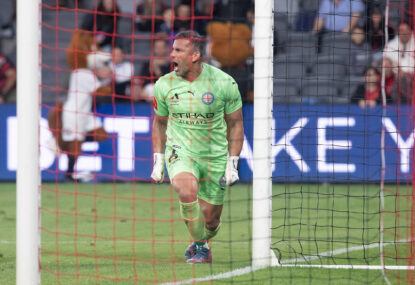Socrates: Tell me Master, you are an internationally renowned philosopher and guru of football, I am sure that many of your fans would like to know what is your favourite aspect of the beautiful game of football?
Laozi: Are, yes, Mr Socrates. That is a very wise question. My favourite aspect of the beautiful ancient game of football is the pass.
Socrates: The pass, Master? That is a strange response. Most football experts adore a beautifully taken shot at goal, or a header accurately fired past the goalie from a set piece, or a perfectly timed sliding tackle, or a spectacular horizontal save from a keeper or even a sublime piece of magic that an attacker works with his or her feet to bewitch and beat a defender. Surely a pass is one of the least beautiful things in football.
Laozi: Perhaps if I shared a little piece of my footballing philosophy you would see why I consider the pass the highest form of football art.
Socrates: Yes, please Master. That would be most instructive.
Laozi: Very well, Mr Socrates. Let me tell you that the first thing that I teach my football students is…
“Thirty spokes share the wheel’s hub;
It is the centre hole that makes it useful.
Shape clay into a vessel (bowl);
It is the space within that makes it useful.
Cut doors and windows for a room;
It is the holes which make it useful.
Therefore profit comes from what is there;
Usefulness from what is not there.”
Socrates: That is very poetic, great Master, and quite beautiful, but you may need to explain in a little more detail how that relates to football and passing.
Laozi: Very well, Mr Socrates. Please enlighten me as to what you perceive the word pass to mean.
Socrates: Well, a pass is when one footballer in possession of the ball moves the ball on to another player by kicking the ball to him or her.
Laozi: Precisely, sir. Several players – often being marked by opposing players – and a ball are the things that are there. The players are like the wheel, or the hub, or the axle, or the bowl, or the room, or the window that I refer to in my ditty. The players and the ball have potential, but they are not inherently useful in themselves. Something provides usefulness. Thinking about my little ditty, Mr Socrates, what do you think it is that could make the situation useful?
Socrates: Well, clearly you refer to space and holes several times, Master, but I think you will have to explain in a bit more detail.

(Photo by Quality Sport Images/Getty Images)
Laozi: Now we get down to the nitty gritty, my friend. I watch a lot of football and so often I see passing done poorly. The main reason why passing is often done very badly is because many players see it as a one-person operation or more accurately an operation where one person acts, then a second person acts to complete the exercise. In other words, someone passes and then someone receives.
Socrates: But surely that is an accurate assumption, Master. One player does pass and then another player does receive.
Laozi: No, sir. Not when football is played properly. When a pass is executed properly both the passer and receiver are dynamically active from the first moment to the last. Even at the highest level, you often see two or three players standing passively some distance from their team-mate who is in possession, yet they seem to have an expectation that their team-mate will want to direct the ball to them.
Sometimes the ball does come to one of these players and a defender immediately shuts down the new ball carrier thus rendering the executed pass almost useless as the ball is now in a place no more useful than it was before. To make the play useful, both the passer and the receiver must simultaneously create space that will render the play useful and put pressure on the defence.
Socrates: Aha! Now this is starting to sound interesting. Explain how the receiver can do such a thing.
Laozi: Ah… there are many ways. Here are just two of my favourites. The simplest one, in Australian Rules football and in basketball, is often referred to as creating a lead. This simply means that the player who wishes to receive the ball, at the same time as she or he is observing the player in possession taking their first touch, might make a small body fake to trick any nearby defender into thinking that they are moving one way or another, then they break as fast as they can in the direction of the passer so that useful space is created between the receiver and defending players.
At the same moment, the player in possession, who should be observing the full field with his or her head up to determine the best option available will spy the player making the break and deliver the ball to an area of useful space in front of where the player creating the lead is heading.
This is why I love the pass so much. Even in a simple situation like this we have co-ordination, we have chemistry, we have flow between two individuals who are working together to create a threat against their opponent. Not static. Not linear. Not ‘I do something, then you do something’. With a good pass, we jointly exploit space to make the situation useful! That’s why a great pass is so much better than a shot or a save or a tackle. Seeing people work in harmony, for me, is so much more fun than individual brilliance.
The lead does not have to be a major movement over many meters. It can be. But it doesn’t have to be. Just a quick dart of a meter or two – just so the receiver can release themselves from the defender – executed just as the pass is being sent can create some beautiful space that a clever player will be able to use against his or her opponent.
Socrates: Thank you, Master. That is indeed fun. But you were going to provide another example.
Laozi: Ah, yes. This other option I was thinking of is almost the opposite of the lead described before. The player who wishes to receive the ball, on seeing their team-mate make their first touch, can quickly fake towards the passer pretending that they are going to create a lead thus causing the defender to transfer their weight onto their front foot in an attempt to follow the escaping player.
Suddenly, the player wishing to receive the ball spins and heads in the exact opposite direction, rocketing past the wrong-footed defender and fleeing at full speed towards the goal. The observant passer, having seen the receiver’s fake, sends a perfectly timed pass so as not to place the receiver off-side into useful space many meters beyond the embarrassed and floundering defender who has misread the play completely.
The receiver, now unmarked, is in the perfect position to do enormous damage to the opponents. This is a more difficult pass than the one to a player creating a lead because the passer has to either direct the pass through the line of defence or to, even more spectacularly, lob the ball over the head of the confused defender but, when done well, it creates havoc with the defence.
This play is particularly useful when the potential receiver perceives that the nearby defender is overplaying or over-defending the passing lane, pressing close to prevent the receiver from getting the ball. The closer the defender is, the more easily they are fooled, and the more embarrassed they will feel when the receiver burns them! I love this kind of pass!
Socrates: That sounds risky and difficult, Master.
Laozi: It is risky and difficult if the players involved think that passing is a linear, ‘one player passes and then one player receives’ activity rather than a joint action. If, however, the passer and receiver constantly work together at practice with a view to transforming open space into useful space using team work then even the impossible becomes possible over time.
Socrates: Wow. I get it. A bowl is only rendered useful by the space that holds the food or water. In itself, the bowl has no value. A wheel is only useful courtesy of the open space where an axle can be inserted. The same, of course, is true of the door, the room and the window. It’s all about creating useful space.
Laozi: Yes. And the highest art of the beautiful game of football is when a team works together to create useful space to inflict maximum damage on their opponent through their passing game.




































































































